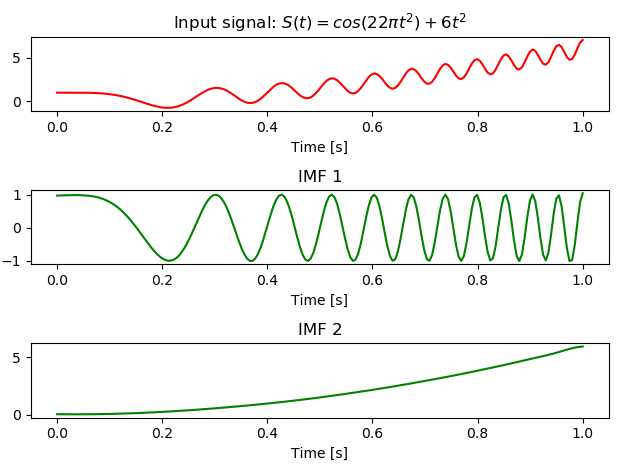信号分解 - PyEMD
Posted yanshw
tags:
篇首语:本文由小常识网(cha138.com)小编为大家整理,主要介绍了信号分解 - PyEMD相关的知识,希望对你有一定的参考价值。
安装:pip install EMD-signal
文档:https://pyemd.readthedocs.io/en/latest/
我大概看了原理,看的不是特别明白,只记录一下我觉得有用的地方
EMD,经验模态分解,是一种信号分解的技术;
它提出了一个概念叫 基本模态分量 IMF,
EMD 用于处理非平稳信号,可用于任意数据,基于数据本身进行分解;
EMD 把一个信号分解成 多个 IMF,每个 IMF 具有线性和非线性的特点,还有一个 信号残余分量,常常代表信号的直流分量或者信号的趋势;
EMD 分解得到的 IMF,频率逐渐降低,尺度各不相同;
EMD 分解得到的前几个模态分量,通常集中了原始信号中最显著、最重要的信息;
EMD 分解容易造成 模态混合,表现为下列现象之一:
1. 在同一个 IMF 中,尺度分布范围很宽却又各不相同的信号;

2. 在不同 IMF 中,存在尺度相近的信号;
模态混合使得 IMF 失去单一特征尺度,形成尺度混杂的震荡,失去原有的物理意义
EEMD,集合经验模态分解,解决了 EMD 模态混合的现象
Python EMD 用法
##### 基本用法 import numpy as np from PyEMD import EMD import pylab as plt s = np.random.random(100) emd = EMD() IMFs = emd.emd(s) ##### 示例 # Define signal t = np.linspace(0, 1, 200) s = np.cos(11*2*np.pi*t*t) + 6*t*t # Execute EMD on signal IMF = EMD().emd(s,t) N = IMF.shape[0]+1 # Plot results plt.subplot(N,1,1) plt.plot(t, s, ‘r‘) plt.title("Input signal: $S(t)=cos(22pi t^2) + 6t^2$") plt.xlabel("Time [s]") for n, imf in enumerate(IMF): plt.subplot(N,1,n+2) plt.plot(t, imf, ‘g‘) plt.title("IMF "+str(n+1)) plt.xlabel("Time [s]") plt.tight_layout() plt.savefig(‘simple_example‘) plt.show()
输出

Python EEMD 用法
from PyEMD import EEMD import numpy as np import pylab as plt def main(): # Define signal t = np.linspace(0, 1, 200) sin = lambda x,p: np.sin(2*np.pi*x*t+p) S = 3*sin(18,0.2)*(t-0.2)**2 S += 5*sin(11,2.7) S += 3*sin(14,1.6) S += 1*np.sin(4*2*np.pi*(t-0.8)**2) S += t**2.1 -t # Assign EEMD to `eemd` variable eemd = EEMD() # Say we want detect extrema using parabolic method # emd = eemd.EMD # emd.extrema_detection="parabol" # eemd.trials = 50 # eemd.noise_seed(12345) # Execute EEMD on S eIMFs = eemd.eemd(S, t, -1) nIMFs = eIMFs.shape[0] # Plot results plt.figure(figsize=(12,9)) plt.subplot(nIMFs+1, 1, 1) plt.plot(t, S, ‘r‘) for n in range(nIMFs): plt.subplot(nIMFs+1, 1, n+2) plt.plot(t, eIMFs[n], ‘g‘) plt.ylabel("eIMF %i" %(n+1)) plt.locator_params(axis=‘y‘, nbins=5) plt.xlabel("Time [s]") plt.tight_layout() plt.savefig(‘eemd_example‘, dpi=120) plt.show() if __name__ == ‘__main__‘: main()
参考资料:
https://www.cnblogs.com/RoseVorchid/p/12030980.html EEMD算法python实现,原理讲得不咋地
http://www.360doc.com/content/19/0806/12/41357686_853284987.shtml# EEMD 原理
https://www.cnblogs.com/mikawong/p/7682467.html 记录了 PyEMD 的一些资源链接
《Adaboost_SVM集成模型的滚动轴承早期故障诊断》 电子书
以上是关于信号分解 - PyEMD的主要内容,如果未能解决你的问题,请参考以下文章